Please refer to The Fundamental Unit Of Life Chapter 5 Class 9 Science Assignments below. We have provided important questions and answers for The Fundamental Unit Of Life which is an important chapter in Class 9 Science. Students should go through the notes and also learn the solved assignment with solved questions provided below. All examination and class tests questions are as per the latest syllabus and books issued by CBSE, NCERT, and KVS. We have also provided Class 9 Science Assignments for all chapters on our website.
Chapter 5 The Fundamental Unit Of Life Class 9 Science Assignments
Question. What is a eukaryotic cell?
Answer
Eukaryotic cells are much larger and more complex than prokaryotic cells. Their complexity is reflected in their DNA content. These cells contain a membrane bound nucleus containing nucleolus. A eukaryotic cell contains many membrane bound cell organelles like the mitochondria, the endoplasmic reticulum and the Golgi bodies. These cells have more than one chromosome and the cell division is by meiotic mode.
Question. What is diffusion?
Answer
The process when gases like CO2 and O2, move across the cell membrane, is called diffusion.
Question. Name two cells with cell wall.
Answer
Onion cell (plant cell) and fungi are two cells with cell wall.
Question. State two conditions required for osmosis.
Answer
(i) The difference in the concentration of water, one should have higher concentration than the other.
(ii) Semi-permeable membrane is also required through which water will flow.
Question. What is nucleoid?
Answer
The nuclear region in some cells are poorly defined due to the absence of a nuclear membrane, it contains only nucleic acid. This undefined nuclear region with nucleic acid in it is called nucleoid.
Question. How many types of proteins are present in cell structure?
Answer
There are two types of protein molecules : intrinsic proteins, which completely covers the lipid bilayer and extrinsic proteins, which occur either on the outer surface or on the inner surface of the lipid membrane.
Question.Why are plasma membrane called selectively permeable membrane?
Answer
Plasma membrane allows to go in and out some materials to and from the cell. It also prevents movement of some other materials. So, it is called selectively permeable membrane.
Question.Where do lipids and proteins get synthesized?
Answer
Lipids get synthesized in the smooth endoplasmic reticulum and proteins get synthesised in the ribosome and rough endoplasmic reticulum.
Question.What would happen to the life of a cell if there was no Golgi apparatus?
Answer
Golgi apparatus plays an important fusion of storage,modification and packaging of the products in vesicles. If there were no Golgi bodies, packaging and dispatching of materials synthesised by the cell will be stopped.
Question. What is the function of chromosome?
Answer
Chromosomes contain information for the hereditary pattern of features from parents to next generation in the form of DNA molecules.
Question. Name the organelles present in liver of animals which detoxifies many poisons and drugs.
Answer
In the liver of animal cells, smooth endoplasmic reticulum helps in detoxifying many poisons and drugs.
Question. Do vacuoles store material? If so, name them.
Answer
Yes, vacuoles store some important substances required in life of the plant cell. These are amino acids, sugars,various organic acids and also some proteins.
Example : Amoeba, vacuoles also store food.
Question. Which cell organelle is known as the ‘suicidal bags’ of a cell? Why?
Answer
Lysosomes are known as suicidal bag of cell. During the disturbance in cellular metabolism, lysosome may burst and the enzymes digest their own cell. Hence, lysosome are called ‘suicide bags’ of a cell.
Question. Write the functions of cell wall in plant cell.
Answer
(i) It provides rigidity and strength to the cell.
(ii) It gives a definite shape to the cell.
(iii) It withstands the osmotic pressure which is developed by cell contents.
(iv) It protects the inner cell organelles bounding the cell from outside.
Question. What are chromosomes? What are they made of?
Answer
The compact rod-like bodies inside the nucleus are called chromosomes. These are seen at the time of cell division. They are made up of deoxyribonucleic acid or DNA and proteins.
Question. What is the function of DNA?
Answer
They are responsible for storing and transmitting hereditary information from one generation to another. They contain the information necessary for constructing and organizing cells.
Question. What is plasma membrane made up of?
Answer
Plasma membrane is made up of proteins and lipids.
Question. How are new cells reproduced?
Answer
Cells multiply by dividing themselves again and again.Cells divide to produce cells of their own kind.
Question.What is a prokaryotic cell?
Answer
A cell in which there is absence of a defined nuclear region and a nuclear membrane is called a prokaryotic cell. Prokaryotic cells are generally small in size. They lack membrane bound cell organelles. They have a single chromosome.
Question. Write a function of cell membrane.
Answer
Its major function is to hold cellular contents and control passage of materials in and out of the cell.
Question. What are genes?
Answer
Gene is a part of DNA. They are located on chromosomes in linear fashions. One gene may perform one or more function. Genes are carrier of genetic character.
Question. Give the function of nuclear membrane.
Answer
The nuclear membrane present as outer covering of nucleus allows transfer of material inside and also out of the nucleus to cytoplasm.
Question. Name various cell organelles.
Answer
The cell organelles are : Endoplasmic Reticulum,Ribosomes, Golgi apparatus, Lysosomes, Mitochondria,Plastids, Vacuoles, Peroxisomes and Centrosome.
Question. Which cell organelle transmits the heredity information from parents to offspring?
Answer
Genes are the functional units of chromosomes which transmit the heredity information from parents to offspring. These are located on chromosomes.
Question. What would happen if the plasma membrane breaks down?
Answer
If plasma membrane breaks down then molecules of some substances will freely move in and out.
Question. What are vacuoles?
Answer
Vacuoles are fluid-filled structures surrounded by a membrane. The fluid in the vacuoles is called cell sap In animal cells, either they are absent or are very small in size.
Question. What is plasmolysis?
Answer
When a living plant cell loses water through osmosis there is shrinkage or contraction of the contents of the cell away from the cell wall. This phenomenon is known as plasmolysis.
Question.How does a living cell perform basic functions?
Answer
A living cell perform basic functions by division of labour among specific components within it is known as cell organelles.
Question. What is the function of vacuoles?
Answer
Vacuoles are the storage sacs for solid or liquid content.In plant cells, it provides turgidity and rigidity to the cell. In single-celled organisms, vacuoles store food, e.g. amoeba.
Question. Who gave the cell theory? What does it state? Which organism is an exception of cell theory?
Answer.
Two biologists; “Schleiden and Schwann” gave the“Cell theory” which expanded by “Rudolf Virchow”.
Cell theory states that :
(i) All plants and animals are composed of cells.
(ii) Cell is the basic unit of life.
(iii) All cells arise from pre-existing cells.
Viruses are the exceptions of cell theory.
Question. What is membrane biogenesis?
Answer. The endoplasmic reticulum helps in the manufacture of proteins and fat molecules or lipids which are important for the cell function. These proteins and lipids helps in the building of the cell membrane. This process is known as membrane biogenesis.
Question. Distinguish between plasma membrane and cell wall.
Answer.
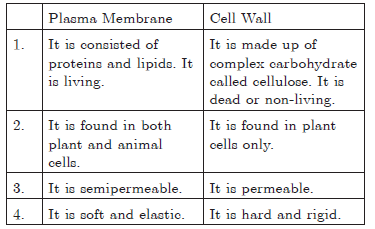
Question. Expand the term ATP. What is use of ATP?
Answer.ATP stands for Adenosine Tri-phosphate
Application : ATP molecules are rich in chemical energy. The body cells use this energy for synthesis of new chemical compounds, and for mechanical work ndone by cells.
Question. Name the cell organelle which are known as :
1. Control centre of the cell
2. Demolition squads/suicidal bags of the cell
3. Export firms
4. Powerhouse of the cell
5. Kitchen of the cell
6. Internal transport system
Answer.
1. Nucleus
2. Lysosomes
3. Golgi bodies
4. Mitochondria
5. Chloroplast
6. Endoplasmic reticulum
Question. What are the function of endoplasmic reticulum and lysosome.
Answer.(a) Functions of endoplasmic reticulum :
(i) It forms supporting skeletal framework of the cell.
(ii) ER provides a pathway for the distribution of nuclear material from one cell to the other.
Question. How does fungi and bacteria can withstand much greater changes in the surrounding medium than animal cells?
Answer. The cell wall present in fungi and bacteria permits these cells to resist very dilute external medium without bursting. Water is taken up by osmosis.
Hence, cells swell and build the pressure against the cell wall. The wall exerts an equal pressure against the swollen cell. It is because of the cell wall, such cells can resist much greater changes in the surrounding medium than animal cells.
Question. (i) What will happen when eukaryotic cells are placed in hypotonic solution?
(ii) What will happen if eukaryotic cells are placed in hypertonic solution?
(iii) What will happen if eukaryotic cells are placed in isotonic solution?
Answer.
(i) When eukaryotic cells are placed in hypotonic solution, the water molecules will enter into the cell and the cell will swell up.
(ii) If eukaryotic cells are placed in hypertonic solution, the water molecules will come out of the cell and the cell will shrink.
(iii) If the eukaryotic cell is placed in isotonic solution, the amount of water molecule will remain the same; it will neither move out nor will go inside.
The cell will remain same sized.
Question. What is lacking in a virus which makes it dependant on a living cell to multiply?
Answer.
Viruses do not have a basic structural organization to perform various life processes in their own as they look selectively permeable process membrane. After entering in a living cell, a virus utilizes its own genetic material and machinery of host cell to multiply.
Question. What are the types of cell on the basis of type of organization?
Answer.
(i) Prokaryotic cells : Cells which have less developed nucleus and without nuclear membrane and nucleolus. These are primitive and incomplete cells. E.g. bacteria.
(ii) Eukaryotic cells : Cells which have well developed nucleus with nuclear membrane and nucleolus.
E.g. plants and animals.
Question. Give difference between Chloroplasts and Chromoplasts.
Answer.
Chloroplasts :
(i) They are green plastids.
(ii) They contain chlorophylls and carotenoids.
(iii) Lamellae are present.
(iv) Chloroplasts are sites of photosynthesis.
Chromoplasts :
(i) They are non-green coloured plastids.
(ii) Chlorophylls are absent.
(iii) Lamellae are absent.
(iv) They add colour to the organs for attracting animals to perform pollination and fruit dispersal.
Question. Give difference between light and electron microscope.
Answer. Light microscope :
(i) It uses glass lenses.
(ii) It uses a beam of light to illuminate the object.
(iii) Internal vacuum is not required.
Electron microscope :
(i) It uses electromagnets.
(ii) It uses a beam of electrons instead of light.
(iii) Internal vacuum is essential.
Question. Give difference between ribosome and centrosome.
Answer. Ribosome :
(i) It is found in both animal cell and plant cell.
(ii) These are dense, spherical and granular particles which occur freely in the matrix or remain attached to the endoplasmic reticulum.
Centrosome :
(i) Centrosome is found only in animal cells.
(ii) It consists of two granules like centrioles.
Question. How does amoeba obtain its food?
Answer. Amoeba take its food by the cell membrane which forms the food vacuole.
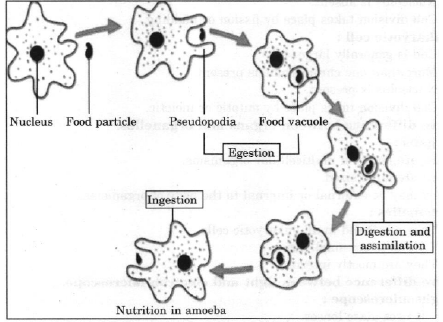
Figure: Food engulf process of amoeba
Question. Who discovered cells in living organisms? Give an example of unicellular organism.
Answer. Leeuwenhoek (1674) was the first to observe the free living cells in pond water. Example of unicellular
organisms : Amoeba, Chlamydomonas, Paramoecium, Bacteria, etc.
(b) Functions of lysosomes :
(i) Lysosomes serve as intracellular digestive system. They destroy any foreign material which enters the cells such as bacteria and virus.
(ii) Lysosomes also remove the worn out and poorly working cellular organelles by digesting them to make way for their new replacements.
Question. Explain the structure and function of Golgi bodies.
Answer. Golgi bodies consist of a system of membrane-bound vesicles arranged in stacks parallel to each other called cisterns. These membranes are connected with the membrane of endoplasmic reticulum (ER).
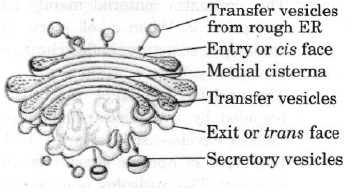
Figure: Golgi apparatus
Functions of Golgi apparatus :
(i) Golgi apparatus packages and dispatches the material synthesized in the cell.
(ii) Golgi complex is also involved in the formation of lysosomes.
(iii) Golgi apparatus is also involved in the synthesis of many substances such as polysaccharides, glycoprotein, etc.
Question. Give difference between plasma membrane and cell wall.
Answer.

Question. Explain the structure of nucleus. Give a neat labelled diagram of a nucleus of cell. Give brief information about nucleus.
Answer. Nucleus is the control centre of the cell. It is covered by a double layered envelope called nuclear membrane.
The nuclear membrane has some pores which allow the transfer of material from inside the nucleus to cytoplasm. Inside the nuclear membrane some thread like structures are present. This is known as chromatin material.

Figure: Structure of a nucleus
The chromatin material mainly formed through DNA (deoxyribonucleic acid) and proteins. When a cell starts to divide, chromatin material condenses into rat-shaped structures called chromosomes. The chromosomes contain DNA which are called genes.
The nucleus is a large, centrally located spherical cellular component. It is bounded by two nuclear membranes, both forming a nuclear envelope. The nuclear envelope separates the nucleus from the cytoplasm. Within nucleoplasm two types of nuclear structures are embedded : the nucleolus and chromatin material. The nucleolus may be one or more in number and is not bounded by any membrane. It is rich in protein and RNA molecules and acts as the site for ribosome formation.
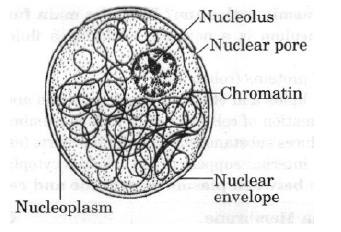
Figure: Nucleus
Question. Explain the following terms : (a) Plasma membrane,
(b) Cytoplasm, (c) Nucleus.
Answer.
(a) Plasma membrane : It is a thin membrane which controls the passage of materials in and out of the cell. It is also called selectively permeable membrane. It makes the outer boundary of the cell and is made up of protein.
(b) Cytoplasm : It is transparent jelly-like thick substance present in the cell. It makes the ground of the cell in which all the cell organelles are suspended.
(c) Nucleus : It is a double-layered membrane structure which contains chromosomes required for the inheritance of characteristics from one generation to the other.
Question. Explain fluid mosaic model of plasma membrane.
Answer. According to fluid mosaic model, plasma membrane is made up of a bilayer of phospholipids. There are two types of protein molecules : Intrinsic proteins, which
completely covers the lipid bilayer and Extrinsic proteins, which occur either on the outer surface or on the inner surface of the lipid membrane. The fluid mosaic membrane has been described as “a number of protein icebergs floating in the sea of lipids”.
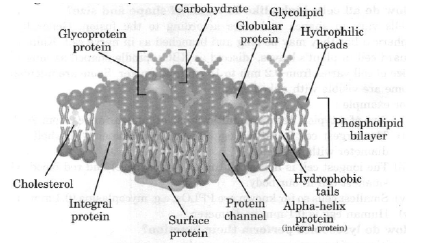
Figure: Plasma membrane
Question. Give difference between diffusion and osmosis. Write any two examples where a living organism uses osmosis to absorb water.
Answer.

Example of Osmosis :
(i) Plant roots absorb water.
(ii) Unicellular organisms such as amoeba absorb water from freshwater.
Question. What would happen if when we put an animal cell into a solution of sugar or salt in water?
Answer.
The following three things could happen :
(i) If the solution surrounding the cell is very dilute than cytoplasm, the water will move into the cell, i.e., the cell will gain water.
(ii) If the solution has exactly similar water concentration as that of cytoplasm of cell, there will be no net movement of water across the cell membrane, i.e., no gain or loss of water from the cell.
(iii) If the medium (solution) has a lower concentration of water than the cell, i.e., the solution is concentrated, the cell will lose water by osmosis.How do all cells look alike in terms of shape and size?
Answer. Cells vary in shapes and sizes according to the fusion. Generally, cells are spherical but they may be long and branched as in nerve cell, Kidney shaped as guard cell in plant’s leaves, discoid as RBC, spindle shaped as muscle cell, etc. Size of cell varies from 0.2 mm to 18 cm in diameter. Some are microscopic while som are visible with naked eyes.
For example :
(i) Size of a typical cell in a multicellular organism ranges from 20-30 mn.
(ii) The largest cell is ostrich egg (15 cm in diameter with shell and 8 cm in diameter without shell).
(iii) The longest cell is nerve cell (up to 1 m. or more) and red blood cells are the smallest cell in our body.
(iv) Smallest cells so far known are PPLOs, e.g.
mycoplasma (0.1 mm in diameter).
(v) Human egg is 0.1 mm in diameter.
Question. Give difference between hypotonic solution, isotonic solution and hypertonic solution.
Answer.
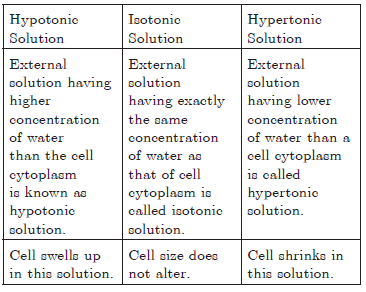
Question. How do lysosomes perform their function?
Answer. Functions of lysosomes :
(i) Extracellular digestion : Sometimes lysosome enzymes are released outside the cell to break down extracellular material.
(ii) Destruction of foreign material : Lysosome also destroys any foreign material which enters inside the cell such as bacteria.
(iii) Cellular digestion : Enzymes are released in damaged cells, ageing cells or dead cells. These enzymes digest their own cell.
Lysosomes contain about 40 hydrolytic enzymes.
Lysosomes burst and their enzymes digest their own cell when the cell gets damaged. So, lysosomes are called ‘suicide bags’.
Foreign materials entering the cell, such as bacteria or food, as well as dead old organelles in the lysosomes break up into small pieces.
Question. Give the difference between plant cell and animal cell.
Answer.
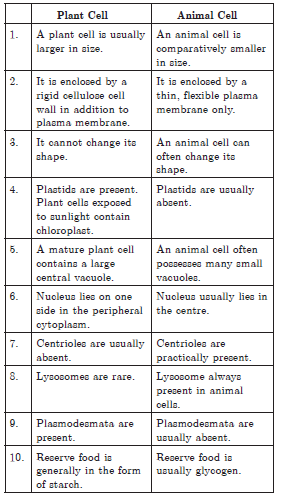
Question. What types of enzymes are present in the lysosomes?What is their function? Which organelle membranes manufacture these enzymes?
Answer.
Lysosomes contain powerful digestive enzymes capable of breaking down all organic material.
Lysosomes help to keep the cell clean by digesting worn out cell organelles and foreign material such as bacteria or food.
RER (Rough Endoplasmic Reticulum) makes the digestive enzymes present in the lysosomes.

